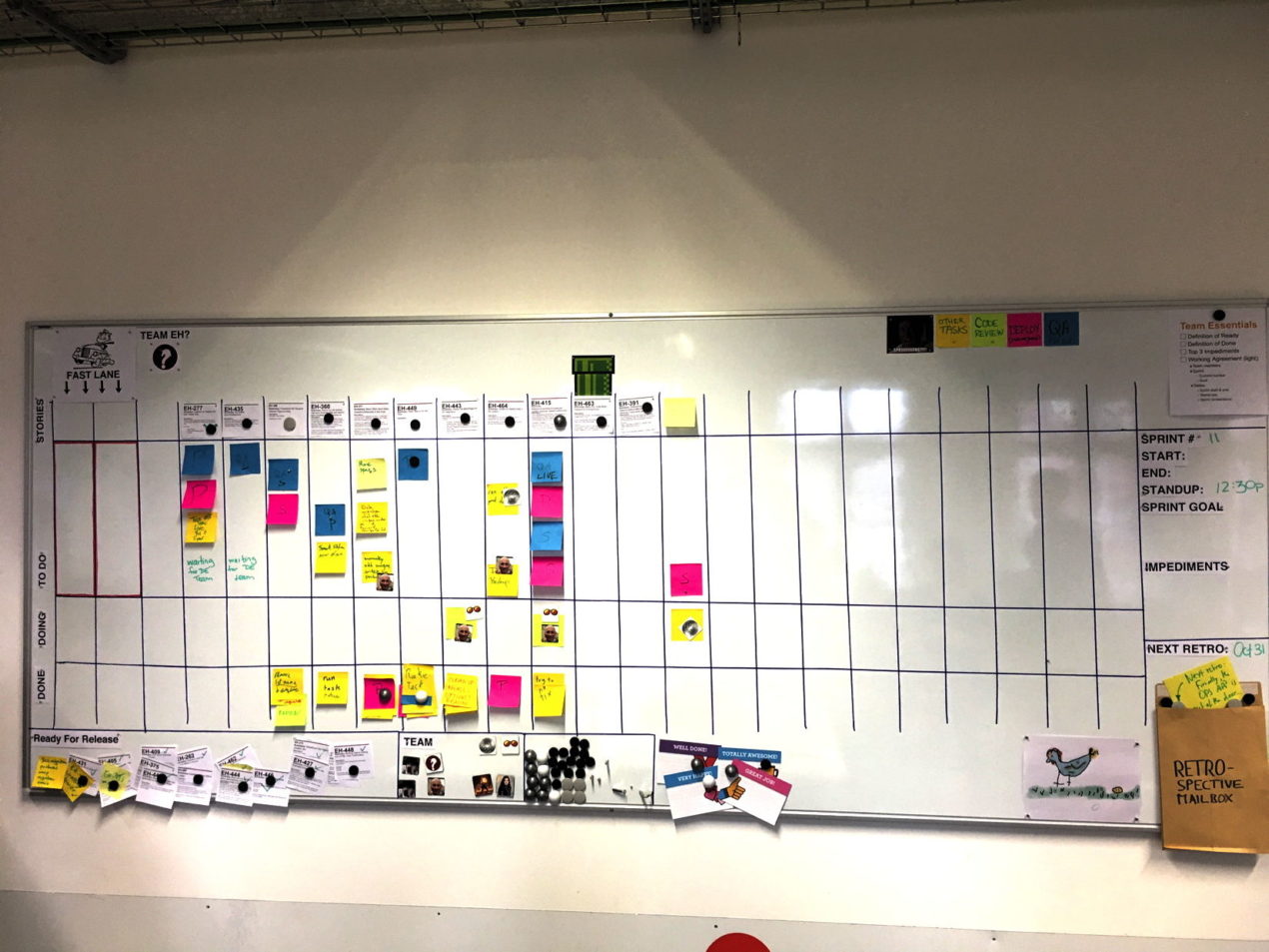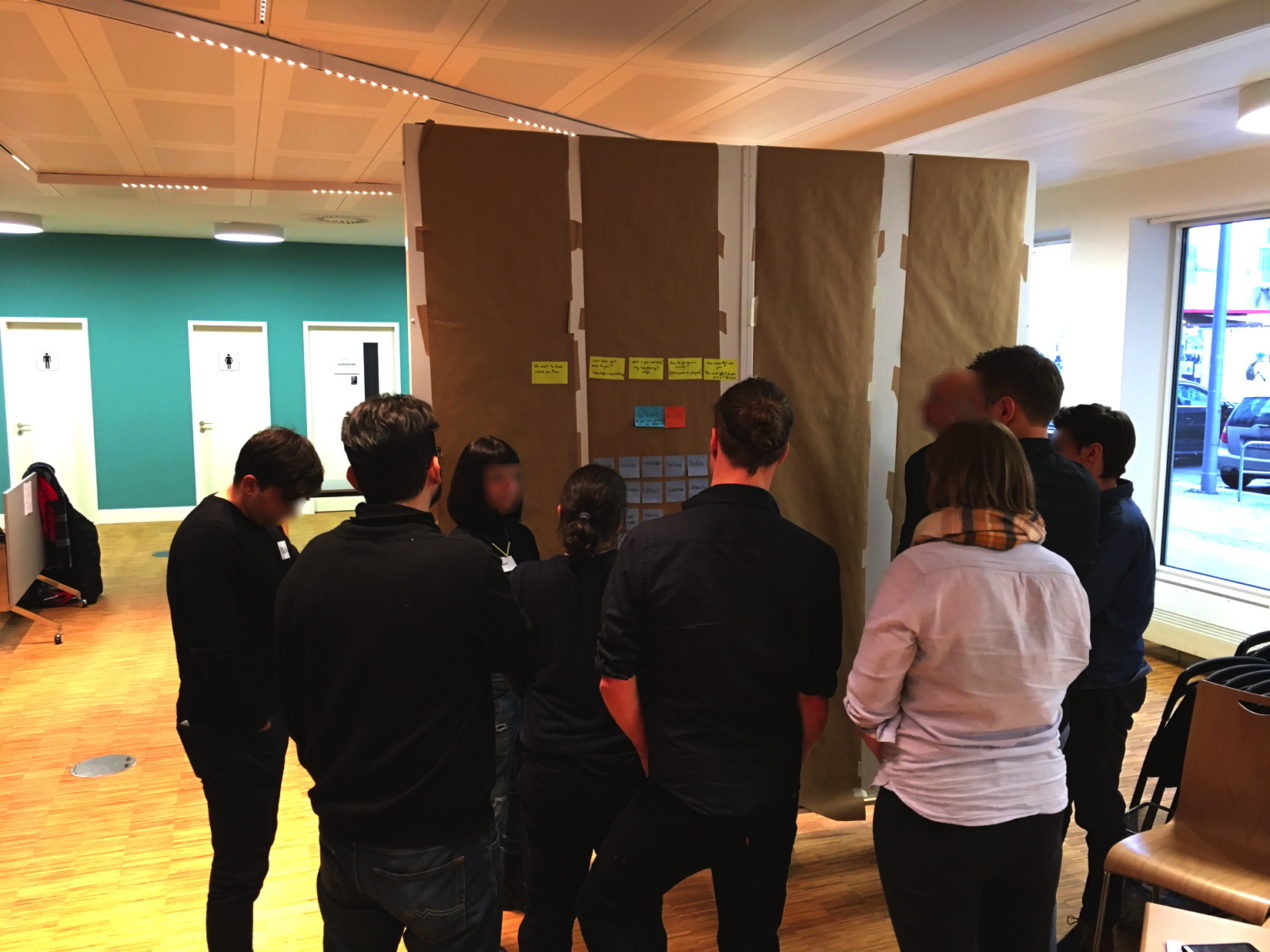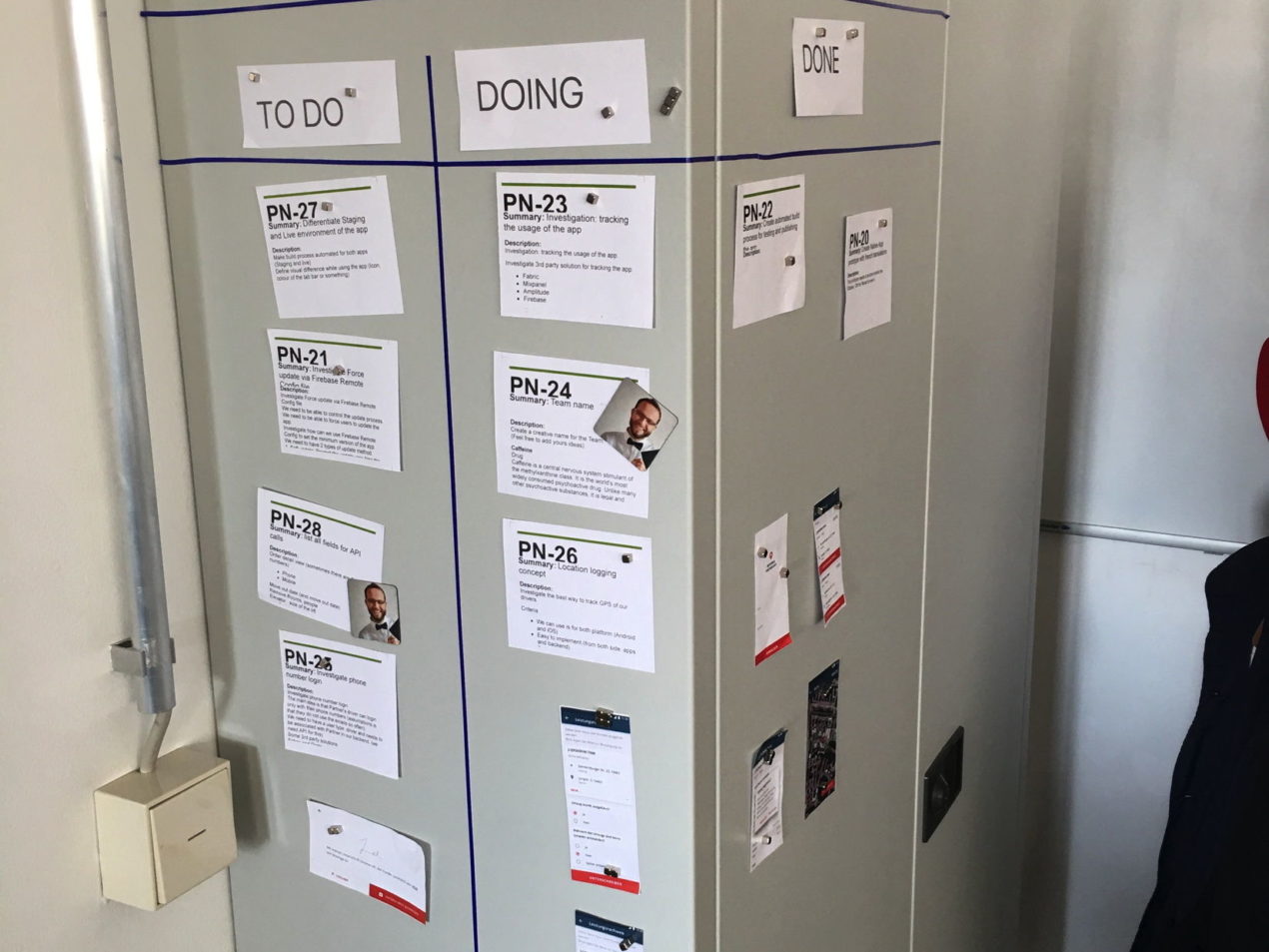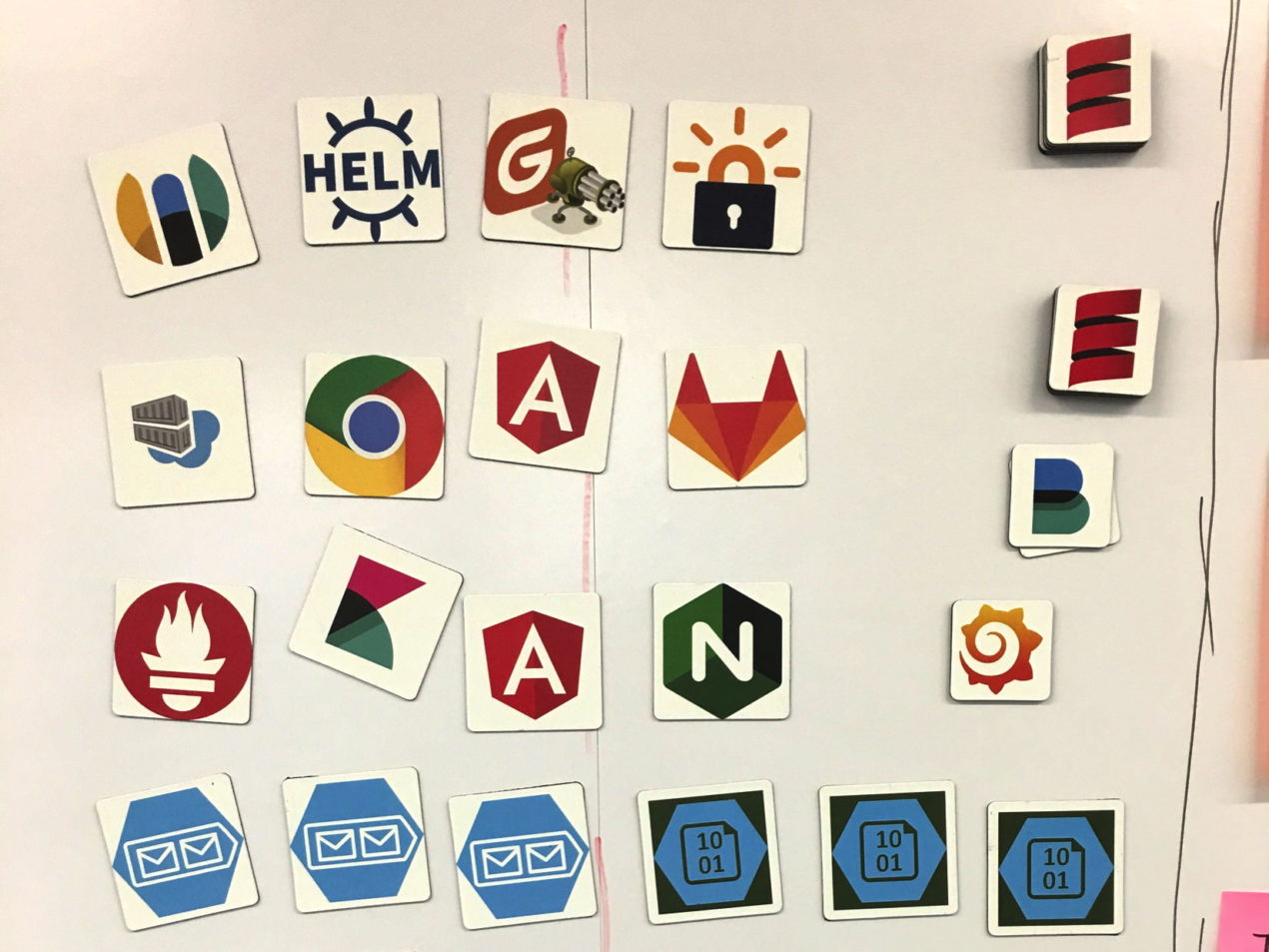TL; DR – How to Create Whiteboards
Learn how to create whiteboards: Whiteboards are magic as they support foundational agile principles such as interaction, collaboration, face-to-face communication, or transparency. They facilitate adapting to change, continuous improvement, and the self-organization of the team. You can create meaningful software with a few index cards, pins (or magnets), pencils, and drywall—you do not need Jira or any other agile process management tool.

Do you want to get this article in your inbox? You can sign up here and join 24k other subscribers.
Use Cases of Whiteboards
The first application of a whiteboard that comes to the mind of an agile practitioner is probably a sprint board. Too often, though, is our imagination limited to the available ‘whiteboard space.’ It turns out that whiteboards are not just well suited to display a sprint backlog or the workflow and workload of a team.
Whiteboards make excellent information radiators in general: from product backlogs, product roadmaps and experimentation and hypotheses backlogs, to visualization of technical debt or architecture diagrams, to impact mapping or user story mapping. Whiteboards provide instant transparency and invite collaboration with other team members or stakeholders. Also, whiteboards prove particularly useful in explaining team processes to stakeholders and new team members. By comparison to printed posters that seem to be both static by nature as well as ‘approved’ before printing, whiteboards invite to challenges the depicted status quo-as they can be changed both quickly and reversible.
Lastly, a “whiteboard” in the sense of this article is not necessarily magnetic although those are more versatile. A drywall will do, as will a thick layer of cork.
Getting Practical: How to Create Whiteboards
There are four basic techniques to get offline boards:
- Buy movable whiteboards on wheels and place them somewhere in the room. (There is a variety of choices, from stylish to crude will-get-the-job-done.
- Install prefabricated magnetic whiteboards on walls. It is the most expensive option with regard to cost per square meter. Moreover, often ready-made boards are either too small, or the boards do not fit the available wall space. Setting them up in the middle of the room can become a wobbly installation.
- An excellent alternative to ready-made whiteboards is plain non-magnetic drywall. It is great for index cards as long as you are willing to use pins. You can achieve a similar effect with covering a wall with cork or other soft materials.
- Lastly, another alternative is turning a wall into a magnetic whiteboard. A client recently transformed about 20 meters of drywall into a huge whiteboard – almost 3 meter high – at the cost of about $ 70 per square meter. (We run meanwhile also product backlog refinements in front a part of this mega-whiteboard.)
Of course, windows and doors are probably usable as improvised whiteboards, too, depending on what is acceptable in your office. (I am aware that asking for forgiveness is presumably easier than asking for permission. However, if you are in doubt, I suggest asking the facility management. Some of those folks are really protective due to numerous safety and governance rules.)
Whiteboard Supplies
There are apparent whiteboard supplies such as magnets, pins, index cards or PostIts/stickies. While index cards need to be principally motived to stick to the surface of the whiteboard, stickies may work temporarily without additional means depending on the surface and the quality of the stickies. (I suggest using ‘super-sticky’ stickies anyway, but even those submit to gravity sooner or later.)
Whiteboard markers that can be removed from whiteboard without a cleaner should be the only markers around your office. (I am aware, that there are fewer colors available for whiteboard markers.) The trouble regularly starts with mixing whiteboard markers with permanent markers for flipchart paper. Honestly, I find it hard to understand why the latter is still purchased given the high removal costs if they are used on whiteboards without being removed immediately. (Have a bottle of cleaner handy for that purpose; the ones containing alcohol are usually up to the job.)
Drawing lines on whiteboards, for example, to mark columns or swim-lanes can be a tricky thing. Using whiteboard markers is not helpful as you will need to redraw them often. Also, team members tend to wipe lines off the whiteboard when working with the board. While it is easy to remove whiteboard markers from whiteboards, removing a black or red whiteboard marker from a white shirt or blouse is a different beast. My favorite line marking tools is hence a very thin, flexible yet sticky tape that is used for painting jobs.
Another essential component of useful whiteboards is magnetic avatars. (We have them printed by a service provider.) We use them for every team member to mark the tasks someone is working on during a sprint. We also use them on the product backlog board to match tasks with teams. (We have a unified product backlog that multiple teams use.) Finally, we use them to visualize the architecture of the application.
How to Use Sprint Boards
Given that whiteboards probably are most often used for sprint backlogs or Kanban boards, here are some practices that have been useful in the past:
- Team name: Put the team name or team logo on the board.
- Team members: Create a list of team members. If you use avatars, match names and avatars here.
- Basic dates of the current sprint: Start with the sprint number, start and end date, the standup time, and probably other ceremonies as well.
- Sprint goal: What are we fighting for this time? Make it visible prominently, written in large readable letters.
- Swim-lanes: Create swim-lanes to make information intake easier: These can be regular lanes, or probably your team likes to separate non-functional tasks and bugs from other tasks. It may be useful to have one swim-lane per tasks to avoid cluttering the board with unaligned stickies or cards.
- Use templates: Standardize the cards or stickies on the board by creating a basic design. This design applies to color-coding cards and markers. For example, always use the same color for bugs and write or print the ticket number at the same spot on the index card or sticky. Reduce the cognitive load and thus make it easy to read a card or sticky from a distance.
- Daily scrum: Run standups in front of the boards and move cards. (This should be a low-brainer but does not seem to be one. There is a reason why salespeople want you to touch new clothes before buying them. The resulting haptic experience already instills a level of perceived ownership. Putting an avatar to a card, moving a card makes it your card, too, supporting self-organization and creating a sense of accountability.)
- WIP – limit the work in progress: There are several ways to limit the amount of work in progress physically. For example, limit the number of magnetic avatars and make it a rule that you cannot work on a ticket without putting an avatar on the stickies. Or limit the available space to place cards – no stacking of cards allowed, of course. Mark stickies with red dots that are not moving to visualize the work item age. This way, the team can reach out to remove the impediment that is preventing progress in time.
- Leading system: If you are using offline and online boards, make sure that there is a leading system and that the boards are synced regularly, for example, right after the standup. This sync is a job of all team members, not a task of the scrum master, by the way.)
Whiteboard Anti-Patterns
As always, you can observe anti-patterns when teams use tools from the agile toolbox. In the case of whiteboards, for example, the most critical whiteboard anti-patterns are:
- Abandoned boards: A team started using a board and then stopped doing so, leaving the old board to rot.
- Dropouts: It is necessary to remind some team members regularly to take care of the board(s).
- Lack of transparency: Not all cards are placed on the board; there is a shadow accounting, blurring the picture.
- Lack of motion: Stickies are not moved regularly, and hence your team experienced sync failures with the other boards. (If this whiteboard anti-pattern persists it renders both boards unusable.)
- Leading system ignored: The working agreement on the lead system is not respected by every team member.
- WIP limit ignored: The team members do not honor the working agreement – reflected in the design of the board – on the work-in-progress limit.
Whiteboard Games
Let us close with another fun part of whiteboards – gaming:
One of my former teams used to identify the team member representing the team at the scrum of scrum ceremony by throwing little magnets at the whiteboard – give it a thought, there are endless opportunities!
How to Create Whiteboards – Conclusions
Whiteboards are one of the most versatile tools from the agile toolbox: simple to create, even quick to improvise, radiating information, and inviting everyone to collaborate and thus becoming a part of the solution.
What experiences – good and bad – have you made with whiteboards? Please share with us in the comments.
📅 Upcoming Webinars
Download your invitations now — there are no more than 100 seats available:
- On June 19th, 2018, the sixth webinar will address product owner anti-patterns.
Note: All webinars are aired from 06:00 to 07:00 PM CEST. (That is 12:00 to 01:00 PM EDT or 09:00 to 10:00 AM PDT.)
📺 Create Whiteboards and Subscribe to Age of Product’s Brand-New Youtube Channel
Now available on the Age of Product Youtube channel:
- Hands-on Agile Webinar #1 on product discovery anti-patterns.
- Hands-on Agile Webinar #3 on agile failure patterns.
✋ Do Not Miss Out: Join the 6,400-plus Strong ‘Hands-on Agile’ Slack Team
I invite you to join the “Hands-on Agile” Slack team and enjoy the benefits of a fast-growing, vibrant community of agile practitioners from around the world.
If you like to join now all you have to do now is provide your credentials via this Google form, and I will sign you up. By the way, it’s free.
How to Create Whiteboards — Related Articles
Download the ‘Agile Transition – A Hands-on Guide from the Trenches’ for Free
📅 Scrum Training Classes, Workshops, and Events
You can secure your seat for Scrum training classes, workshops, and meetups directly by following the corresponding link in the table below:
See all upcoming classes here.
You can book your seat for the training directly by following the corresponding links to the ticket shop. If the procurement process of your organization requires a different purchasing process, please contact Berlin Product People GmbH directly.










Heike, I use Magpics: https://magpics.de/shop/ — fast, reliable, affordable, you can order by invoice. 👍
Stefan, can you recommend a printing company for magnets? Much appeciated!
Thanks Stefan,
This is great article, I like the game part and retrospective mailbox, this mailbox will save many time when we host the retrospective meeting.